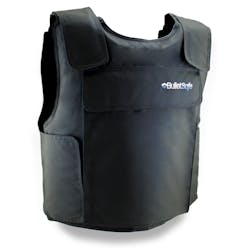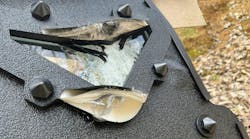There are some growing trends in armor plates that unfortunately expose issues we have in society itself. The growing daily threat to law enforcement has increased and changed how we look at personal ballistic protection.
- This culture change has driven several trends:
- Manufacturers have risen to the task with lighter, more efficient equipment.
- Officers are more likely to have rifle plates in their car than any other moment in history.
- Manufacturers have begun to produce “in conjunction with” (ICW) armor in order to save bulk and weight.
- Independent testing, rather than submitting products for NIJ certification, has become more common.
Ballistic plates worn over soft armor have been made of several different materials, but the most common is ceramic. Plates made of metals like steel are the heaviest, and polyethylene plates are the lightest. When it comes to selecting, I recommend that agencies do something similar when looking at soft armor: Wear plates that, at the very least, are capable of defeating the firearm/cartridge combination that the agency uses.
There are advantages and disadvantages to each material. Consider carefully what your agency does, your replacement policy, and your working environment.
Steel is heavy (8 to 10 pounds), but it is probably the least expensive. Steel users know that the plates often deflect more than they absorb impact, opening the door to ricochet and bullet splatter. Ceramic plates (4 to 8 pounds) are only slightly more expensive, but an errant drop can end their usability. Given the same level of protection (for example, Level III), a ceramic plate will likely be thinner than a polyethylene plate. Polyethylene is very light (2 to 5 pounds), but usually more expensive. They can handle edge-to-edge drops and some poly plates even float. However, most poly plates are not armor-piercing projectile resistant, even when used as an ICW product. They also can’t be left in a vehicle on a hot summer day. Some manufacturers have been producing hybrid polyethylene/ceramic plates in order to meet the armor piercing requirement.
Although it is predictable that most patrol officers who handle enforcement-like duties will have a ballistic vest, it is only recently that officers have begun to respond with rifle protection at the patrol level. Although the circumstances that have caused this trend are a little disconcerting, the prudence of continuing this trend is self-evident. Every officer that swears in for duty should have a primary vest and the ability to add rifle protection readily available at the first responder level.
Not every officer wears a vest, but anecdotal data suggests that more officers are wearing them in the past few years. The top reason why some officers do not wear a vest: comfort. Some agencies cannot afford to purchase vests for officers. If you are a peace officer in one of those agencies, please go to Vestforlife.com. If you can make a charitable donation, or have a vest to donate, this is the place.
The NIJ Standard 0101.06, known more commonly in the trade as “NIJ .06,” is a minimum performance standard developed in collaboration with the Office of Law Enforcement Standards (OLES) of the National Institute of Standards and Technology. The testing program is produced as part of the standards and testing program of the National Institute of Justice, hence the NIJ .06 designation. Products do not receive NIJ compliance unless they submit their products. The products are tested according to pre-design protocol. If they pass the tests, they are considered compliant.
Some manufacturers, and others related to the industry, do their own independent testing. Some of this testing is similar to NIJ standards. However, certification only comes through NIJ.
If the standards are set by a given institution, why would a company decide to go with independent testing? There are several reasons, but the most current product trend suggests that armor manufacturers are responding to the specific needs of the industry and law enforcement agencies are benefiting from this response.
The main reason independent testing is taking place is the fact that users really need to trim down the weight and bulk of using armor. For example, elite teams sometimes go away from NIJ standards. The logic is pretty simple. Body armor plates are tested independently. That is, when they are tested, there is no ballistic vest behind them. However, users don’t wear secondary armor without ballistic plates underneath. The combination of both products is pretty heavy and bulky. Using a lighter plate combined with a vest might possibly provide the same effectiveness, with a little more maneuverability.
ProTech Tactical responded to this need with armor they call “in conjunction with” or ICW products like the XCAL-LP. This type of plate has to be worn with body armor. When it is tested independently, it is utilized with a specific armor product. This type of innovation is not written into the NIJ standard. The truth is, this product combination is quite popular with elite units. (NIJ Standard 0101.06 does have an in conjunction specification that corresponds with Type III armor and plates, but it specifies 7.62 x 39 M80 ammunition.)
I spoke with Dan McNeil, Director for Tactical Armor at The Safariland Group, on why independent testing meets the needs of specific agencies. His experience spans 17 years in various aspects of ballistic protection.
McNeil says, “If you’re looking at the plates being sold, you’ll see that the market has grown dramatically with school shootings.” Patrol officers have generally worn ballistic vests. The vests often are equipped with some sort of trauma plate which add to the ballistic capabilities. The growing trend is the fact that individual patrol officers and entire agencies have been purchasing 10 x 12 plates. They become part of the active shooter response kit for the officer.
“Some of the plates we sell are independently tested, because they are special threat tested,” says McNeil. He explains that when you look at the NIJ standard, it is required to handle 6 impacts from a .308 at a specific distance. Purchasers from elite teams often look at the standard and start to think, “If I can get a plate that handles three impacts, and it has a vest under it…”. McNeil explains that ICW plates cannot work independently of the soft armor underneath.
One other aspect of NIJ .06 that has brought about more independent testing is a plate drop test. McNeil says that it “Adds bulk, weight and cost, but doesn’t add to the ballistic ability of the plate.” Armor plates are dropped onto a platform before they are shot. If the structural integrity doesn’t stay intact, the plate isn’t tested for ballistic ability. Although fracture resistance is definitely a factor in the quality of a plate, the testing method really doesn’t correspond with an impact that would occur if the plate was actually worn.
For armor plates that have complex curves in their design, the plates tend to strike at the apex of the curve.
Independent testing allows some elite units to tailor their armor against a specific threat. This definitely works for military units.
Several manufacturers have begun tailoring their products using threat combination systems. One innovative approach is Angel Armor’s Truth Snap system. They have several styles of plates, designed to resist a specific threat level. Officers can “layer up” their protection by snapping an additional plate over their existing plate. The plates have rare earth magnets that keep the protection in position. Just to answer potential questions here, both the Truth 44 and Truth 47 plates, used in combination, are still less than an inch thick when used together.
What’s the other part of the trend? Entire departments have been purchasing helmets. They are not the old riot shells but ballistic helmets. That is, first responders are more equipped than ever to respond to higher active threat levels.
I got a chance to talk to Tom Nardone of BulletSafe. Tom has an interesting history that eventually steered him toward ballistic protection. Years ago, as an employee of Sikorsky, he noted that the industry began switching their fuel tank liners to polyethylene. The material was stronger and lighter. Tom moved on to work for Ford, but kept his eye on the bullet resistance industry. Eventually, manufacturers began to make ballistic materials out of polyethylene.
Nardone noted that law enforcement agencies were using polymer, but there was still an untapped market. There are other employees in the protection or the armored transport industry that had a need for an inexpensive, lightweight product.
He set out to make cost-effective products. He jokingly explains that they took a “Henry Ford” approach. When it came to soft armor, Bulletsafe realized that their company could not provide the same service as larger companies. Some of the larger companies are capable of sending a fitting representative to a large agency. Officers from those companies basically get a custom fit.
Nardone told me, “Everyone would have custom carriers. We wanted to make a carrier that fit every body.” In order to make it more portable, their vest carriers have generous hook-and-loop material all over the vest. This has driven the Level IIIA BulletSafe product down to $299. Since the carriers go from size S to 2X (4X costs slightly more), they are very small agency friendly.
Another consideration why the BulletSafe system is a great bargain is the fact that the carrier has pockets for front and rear plates. Many other products require a separate carrier.
Nardone says that the rifle plate industry has grown considerably, even from last year. BulletSafe relies on their customer feedback to monitor market trends. He adds that new customer purchases of rifle plates are likely former steel plate buyers. I can tell you that the difference in weight between a steel plate and a polyethylene plate is dramatic. Some steel plates weigh around eight pounds while some polyethylene plates can weigh less than a pound and many are even buoyant.
By the way, this may be a consideration for purchasing a polyethylene plate. Law enforcement officers who work in a marine environment should definitely consider the material.
Trends
I wouldn’t be completely myself unless I predicted what’s coming down the road.
Diamondback Tactical markets a Level II ballistic shirt that actually has a couple of holsters integrated with the shirt. The shirt is designed to cling to the body, and, without the armor, is a 5.11 Tactical product. Diamondback Tactical has integrated the ballistic protection—the Lightning Performance armor. I realize that this armor is currently only Level II, but I see this as a trend. You see, law enforcement officers want to wear their vests under their uniforms, with an option to put a plate package over the top. This shirt is thin, flexible, and isn’t very bulky. One can wear it for normal duty, then throw a couple of plates over it when an increased level of protection is warranted.
I personally think that this is the future of ballistic protection.



